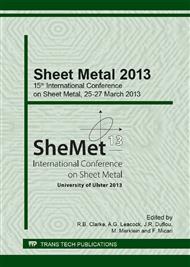[1]
J. Jeswiet, F. Micari, G. Hirt, A. Bramley, J. Duflou, and J. Allwood, "Asymmetric Single Point Incremental Forming of Sheet Metal," Annals of the CIRP, vol. 54, pp.623-649, 2005.
DOI: 10.1016/s0007-8506(07)60021-3
Google Scholar
[2]
E.-L. Odenberger, M. Oldenburg, P. Thilderkvist, T. Stoehr, J. Lechler and M. Merklein, "Tool development based on modelling and simulation of hot sheet metal forming of Ti-6Al-4V titanium alloy," J Mater Process Tech, vol. 211, pp.1324-1335, 2011.
DOI: 10.1016/j.jmatprotec.2011.03.001
Google Scholar
[3]
G. Welsch, and W. Bunk, "Deformation Modes of the (α-Phase of Ti-6AI-4V as a Function of Oxygen Concentration and Aging Temperature," Metall Mater Trans A, vol. 13, pp.889-899, 1982.
DOI: 10.1007/bf02642403
Google Scholar
[4]
R. Neugebauer, T. Altan, M. Geiger, M. Kleiner, and A. Sterzing, "Sheet metal forming at elevated temperatures," Ann CIRP, vol. 55 (2), pp.793-816, 2006.
DOI: 10.1016/j.cirp.2006.10.008
Google Scholar
[5]
G. Fan, F. Sun, X. Meng, L. Gao, and G. Tong, "Electric hot incremental forming of Ti-6Al-4V titanium sheet," Int J Adv Manuf Technol, vol. 49, pp.941-947, 2010.
DOI: 10.1007/s00170-009-2472-2
Google Scholar
[6]
J.R. Duflou, B. Callebaut, J. Verbert, and H. De Baerdemaeker, "Laser Assisted Incremental Forming: Formability and Accuracy Improvement," CIRP Annals - Manufacturing Technology, vol. 56 (1), pp.273-276, 2007.
DOI: 10.1016/j.cirp.2007.05.063
Google Scholar
[7]
J. R. Duflou, B. Callebaut, J. Verbert, and H. De Baerdemaeker, "Improved SPIF performance through dynamic local heating," International Journal of Machine Tools and Manufacture, vol. 48 (5), pp.543-549, 2008.
DOI: 10.1016/j.ijmachtools.2007.08.010
Google Scholar
[8]
T. Biermann, A. Göttmann, J. Zettler, M. Bambach, A. Weisheit, G. Hirt, et al., "Hybrid laser assisted incremental sheet forming: Improving formability of Ti- and Mg-based alloys," in International Conference on Lasers in Manufacturing (LiM), Munich, 2009.
Google Scholar
[9]
A. Göttmann, J. Diettrich, G. Bergweiler, M. Bambach, G. Hirt, P. Loosen, et al., "Laser-assisted asymmetric incremental sheet forming of titanium sheet metal parts," Production Engineering, vol. 5, pp.263-271, 2011.
DOI: 10.1007/s11740-011-0299-9
Google Scholar
[10]
Program fact sheet 787 Dreamliner: http://www.boeing.com/commercial/787family/programfacts.html, Nov 23nd (2012)
Google Scholar
[11]
K.H. Rendigs, "Titanium Products Used at AIRBUS." In G. Lütjering; J. Albrecht (Hrsg.), "Ti-2003 – Science and Technology", vol. 4, p.2659–2666. WILEY-VCH, Hamburg, 2003.
Google Scholar
[12]
W.-S. Lee, and M.-T. Lin, "The effects of strain rate and temperature on the compressive deformation behaviour of Ti-6A1-4V alloy," J Mater Process Tech, vol. 71, pp.235-246, 1997.
DOI: 10.1016/s0924-0136(97)00080-0
Google Scholar
[13]
W.-S. Lee, and C.-F. Chen, "High-temperature deformation behaviour of Ti6Al4V alloy evaluated by high strain-rate compression tests," J Mater Process Tech, vol. 75, pp.127-136, 1998.
DOI: 10.1016/s0924-0136(97)00302-6
Google Scholar
[14]
N.-K.Park, J.-T. Yeom, Y.-S. Na, "Characterization of deformation stability in hot forging of conventional Ti–6Al–4V using processing maps", J Mater Process Tech, vol. 130-131, pp.540-545, 2002.
DOI: 10.1016/s0924-0136(02)00801-4
Google Scholar
[15]
J. Luo, M. Li, H. Li, and W. Yu, "Effect of the strain on the deformation behavior of isothermally compressed Ti-6Al-4V alloy," Mater Sci Eng A, vol. 505, pp.88-95, 2009.
DOI: 10.1016/j.msea.2008.11.001
Google Scholar
[16]
A.J. Wagoner Johnson, C.W. Bull, K.S. Kumar, and C.L. Briant, "The Influence of Microstructure and Strain Rate on the Compressive Deformation Behavior of Ti-6Al-4V," Metall Mater Trans A, vol. 34 (29), 295-306, 2003.
DOI: 10.1007/s11661-003-0331-6
Google Scholar
[17]
M. Vanderhasten, L. Rabet, and B. Verlinden, "AME High temperature Deformation of Ti6Al4V at low Strain Rate," Metalurgija, vol. 11, pp.195-200, 2005.
Google Scholar
[18]
M. Vanderhasten, L. Rabet, and B. Verlinden, "Ti-6Al-4V: Deformation map and modelisation of tensile behaviour," Mater Design, vol. 29, pp.1090-1098, 2008.
DOI: 10.1016/j.matdes.2007.06.005
Google Scholar
[19]
B. Taleb Araghi, A. Göttmann, M. Bambach, G. Hirt, G. Bergweiler, J. Diettrich, et al., "Review on the development of a hybrid incremental sheet forming system for small batch sizes and individualized production," Production Engineering, vol. 5, pp.303-404, 2011.
DOI: 10.1007/s11740-011-0325-y
Google Scholar
[20]
H. Yang, X.G. Fan, Z.C. Sun, L.G. Guo, and M. Zhan, "Recent developments in plastic forming technology of titanium alloys," Sci China Tech Sci, vol. 54 (2), pp.490-501, 2011.
DOI: 10.1007/s11431-010-4206-y
Google Scholar
[21]
R. Pederson, "Microstructure and Phase Transformation of Ti-6Al-4V," Dissertation, Luleå University of Technology, Schweden, p.14,17, 2002.
Google Scholar
[22]
M. Vanderhasten, "Ti-6Al-4V: Deformation Map and Modelisation of Tensile Behavior," Dissertation, Katholieke Universiteit Leuven, Belgium, p.22, 2007.
Google Scholar
[23]
P. Homporova, C. Poletti, M. Stockinger, and F. Warchomicka, "Dynamic phase evolution in titanium alloy Ti-6Al-4V," The 12th World Conference on Titanium, Beijing, China; 19-42 July 2011.
Google Scholar
[24]
S. Kumara, T.S.N. Sankara Narayanana, S. Ganesh Sundara Ramanb, S.K. Seshadrib, "Thermal oxidation of Ti6Al4V alloy: Microstructural and electrochemical characterization," Mater Chem Phys, vol. 119, pp.337-346, 2010.
DOI: 10.1016/j.matchemphys.2009.09.007
Google Scholar


